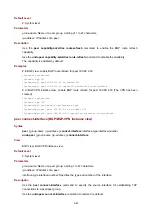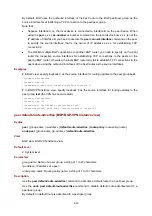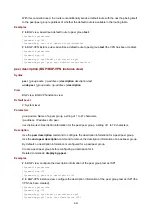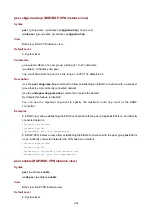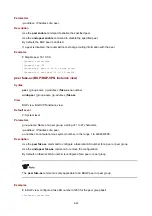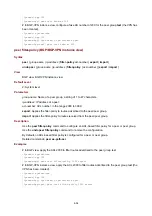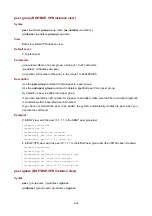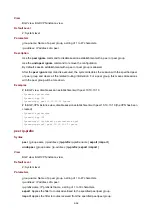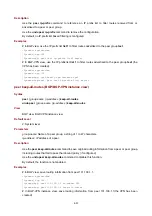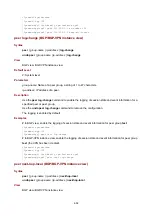
6-62
Description
Use the
peer
public-as-only
command to not keep private AS numbers in BGP updates sent to a
peer/peer group.
Use the
undo peer public-as-only
command to keep private AS numbers in BGP updates sent to a
peer/peer group.
By default, BGP updates carry private AS numbers.
The command does not take effect if the BGP update has both public and private AS numbers. The
range of private AS number is from 64512 to 65535.
Examples
# In BGP view, carry no private AS number in BGP updates sent to the peer group
test
.
<Sysname> system-view
[Sysname] bgp 100
[Sysname-bgp] peer test public-as-only
# In BGP-VPN instance view, carry no private AS number in BGP updates sent to the peer group
test
(the VPN has been created).
<Sysname> system-view
[Sysname] bgp 100
[Sysname-bgp] ipv4-family vpn-instance vpn1
[Sysname-bgp-vpn1] peer test public-as-only
peer reflect-client (BGP/BGP-VPN instance view)
Syntax
peer
{
group-name
|
ip-address
}
reflect-client
undo peer
{
group-name
|
ip-address
}
reflect-client
View
BGP view
Default Level
2: System level
Parameters
group-name
: Name of a peer group, a string of 1 to 47 characters.
ip-address
: IP address of a peer.
Description
Use the
peer reflect-client
command to configure the router as a route reflector and specify a
peer/peer group as a client.
Use the
undo peer reflect-client
command to remove the configuration.
By default, neither the route reflector nor the client is configured.
Related commands:
reflect between-clients
and
reflect cluster-id
.
Examples
# In BGP view, configure the local device as a route reflector and specify the IBGP peer group
test
as
a client.
<Sysname> system-view


